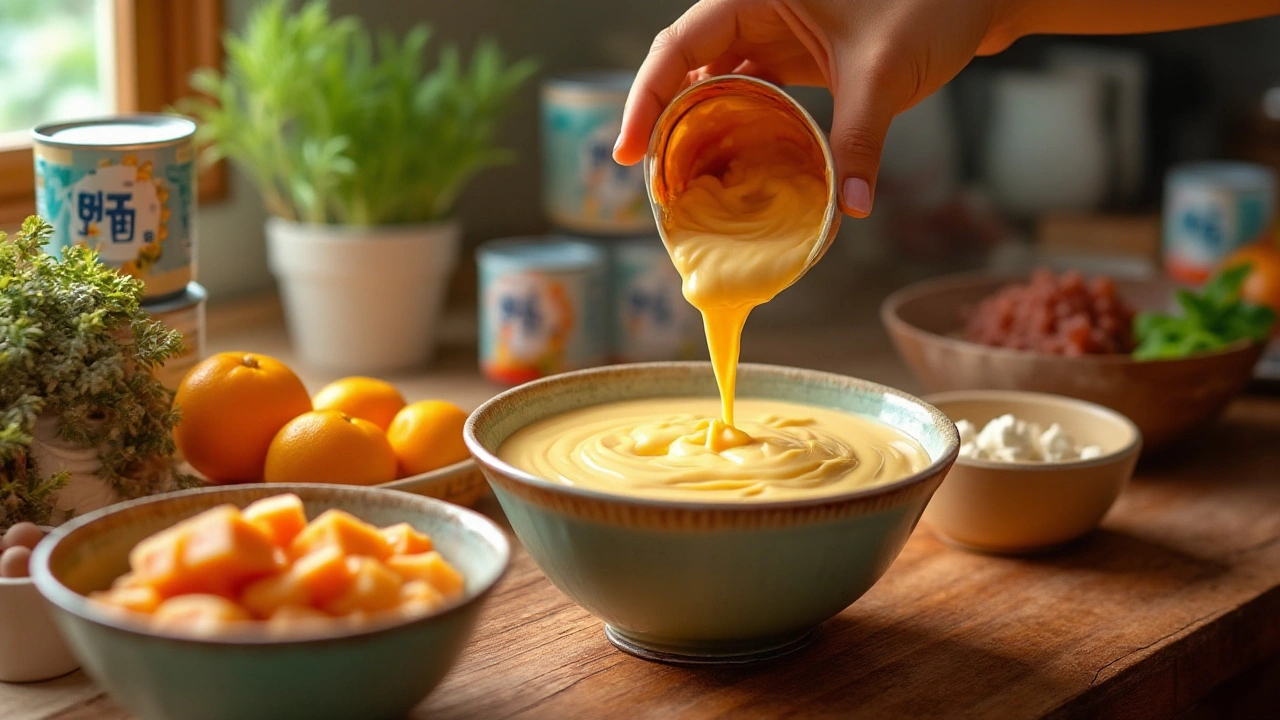
Condensed milk has found a special place in kitchens across Asia, adding a touch of sweetness and a smooth texture to a variety of desserts. It is a beloved ingredient that has transcended generations, helping create unforgettable flavors in recipes like fudge. This sweet, thick milk has a rich history of usage in various countries, intertwining with cultural cuisines in delightful ways.
While condensed milk's simplicity is its beauty, it also opens the door to culinary creativity. In this article, we're going on a journey through the fascinating role condensed milk plays in Asian dessert traditions, particularly in fudge recipes. Whether you're a seasoned chef or a home cook, the versatility of condensed milk could inspire the creation of delicious sweets for friends and family.
- The Origins of Condensed Milk in Asia
- Culinary Benefits of Using Condensed Milk
- Popular Asian Fudge Recipes Featuring Condensed Milk
- Tips for Cooking with Condensed Milk
- Exploring Modern Takes on Traditional Recipes
The Origins of Condensed Milk in Asia
Condensed milk did not originally hail from Asia, yet it has become an integral part of the culinary landscape across many Asian countries. Its journey to the East can be traced back to the mid-19th century. Invented by an American named Gail Borden Jr. in 1856 as a means to preserve milk, the concept quickly spread globally. By the time it arrived in Asia, it was embraced for both its convenience and its ability to add a rich, sweet depth to foods.
During this period of burgeoning trade and exchange, condensed milk became available in nations like India, Vietnam, and Malaysia. Its long shelf life was particularly beneficial given the warm climates, where fresh milk would spoil quickly. With time, people in these regions discovered its versatility and incorporated it into traditional desserts, beverages, and even snacks. Condensed milk was celebrated not just for its sweetness but also for its thick, luscious texture that complemented the diverse culinary styles of Asia.
The adoption of condensed milk in Asia was not just about practicality; it quickly became a part of familial traditions and celebrations. In countries like Thailand and the Philippines, this ingredient is now indispensable in making delectable sweets and treats for various festivals and gatherings. Its presence in recipes often whispers of colonial influences mixed with local adaptability. This fusion has led to classics such as Vietnamese coffee and Thai tea, where condensed milk acts as a defining element in enhancing flavors.
Praise for condensed milk is evident across literature and food writings; it is often cited in social commentaries about the blend of tradition and modernity in food culture. One food historian noted, "Condensed milk is more than just a culinary ingredient in Asia; it represents the intersection of survival, creativity, and the enduring ability of people to adapt foreign elements into their everyday lives."
This ingredient’s popularity soared to the extent that local brands began producing their own versions, tailoring the flavor profiles to match regional tastes. The affection for condensed milk is so profound that it often invokes nostalgia, evoking memories of mothers and grandmothers crafting sweet delights with loving care. Its impact is such that it continues to evolve, marking a sweet spot in both resistance and acceptance in gastronomic history. This cherished ingredient is a testament to the dynamic nature of Asian cuisine, bringing together diverse stories in a rich tapestry of flavor.
Culinary Benefits of Using Condensed Milk
Condensed milk is a culinary marvel cherished in kitchens, particularly for its role in sweets and desserts. Its unique composition brings a range of benefits, starting with its rich taste, which enhances the original flavors of the dish. It adds a natural sweetness, eliminating the need for additional sugar, thereby simplifying the recipe-making process. This is especially true in fudge recipes, where the milky, sweet notes need to be perfectly balanced. Many home cooks find condensed milk to be a pantry staple because it is typically affordable, having a long shelf-life that allows for it to be kept on-hand for spontaneous cooking sessions. When considering the texture, the creamy density of condensed milk provides an unparalleled smoothness to fudges and candies, allowing for a pleasing bite that melts in your mouth.
Another advantage of using condensed milk is its ability to function as a reliable binding agent, which is crucial in creating the perfect consistency for fudge. It amalgamates ingredients beautifully, ensuring that flavors are distributed evenly. The thermal stability of condensed milk allows it to endure the heating process without curdling, an essential quality for candy-making that requires precision in temperature control. For instance, this is why it is often preferred over regular milk in crafting confections because of its ability to produce smoother results. Culturally, the use of condensed milk in various regions across Asia highlights its adaptability; it’s used in everything from petite desserts to grander confections, offering a touch of luxury.
The appeal of condensed milk extends beyond its flavor and texture. According to a survey conducted in 2022, over 65% of dessert enthusiasts in Southeast Asia mentioned that they frequently use condensed milk in their sweets for its consistency and taste benefits. It makes cooking accessible and more foolproof, allowing even novice bakers to achieve professional-grade results. Culinary experts also emphasize the necessity of condensed milk for achieving that perfect balance in recipes. For example, culinary instructor Mei Wong stated, "Condensed milk is the backbone of many of our traditional sweets; it brings everything together."
"In Asia, condensed milk is not merely an ingredient; it is a bridge of taste from one generation to the next," states Dr. Huang, a food historian.This encapsulates the emotional connection as well as the technical advantages it imparts.

Popular Asian Fudge Recipes Featuring Condensed Milk
In the realm of Asian desserts, few ingredients shine as brightly as condensed milk. Its sweetened, creamy goodness has been a cherished companion to many culinary traditions spanning the Asian continent. This versatile ingredient plays a pivotal role in concocting heavenly fudge recipes that are a delight to the senses. Enveloped in a luscious blend of simplicity and tradition, these recipes reflect a harmonious fusion of flavor and texture.
One of the standout recipes beloved in the Indian subcontinent is the 'Chocolate Barfi.' This traditional, decadent treat showcases condensed milk as a key ingredient that lends the fudge its rich, velvety taste. To prepare this, cooks combine ghee and condensed milk with cocoa powder, stirring tirelessly over low heat to achieve the perfect consistency. The result is a firm yet soft fudge that melts in the mouth, accented by crunchy nuts like pistachios or almonds sprinkled atop. The popularity of Chocolate Barfi during Diwali or Eid celebrations ensures its presence as a festive favorite among both elders and youngsters alike.
Traveling over to Southeast Asia, we find the Thai dessert known as 'Khanom Chan.' While not a traditional fudge, this layered delight derives an exquisite creaminess from the use of condensed milk. The subtle inclusion of jasmine essence adds another depth of flavor, creating a more aromatic dessert experience. To achieve its iconic layered effect, each segment of the dessert is carefully conducted in a sequential manner, allowing for incredible visual and gustatory satisfaction. Anyone exploring the authentic flavors of Thailand is sure to have encountered Khanom Chan, an irresistible testament to the bond between food and culture.
A sweet innovation can be discovered in the Philippines with their remarkable 'Yema Cake.' Here, homemade fudge cooked from condensed milk, eggs, and sugar forms a thick, luxurious filling between layers of chiffon cake. The condensed milk not only enriches the fudge center but also elevates the entire dessert with its irresistibly creamy goodness. Widely consumed during festive times and celebrations, this artisanal cake reflects an evolution of traditional taste preferences blending influences from pastuban Filipino, Iberian, and American desserts. The Yema Cake has pierced hearts beyond its origin, resonating with dessert enthusiasts worldwide.
Across these varied recipes, it's clear that condensed milk is at the heart of many cherished Asian confections. Each creation speaks to the tradition of community and family, where shared joy finds its form in bites of chewy, creamy fudge. Renowned culinary expert, Leah Cohen, once remarked that "Ingredients like condensed milk transform simple recipes into profound culinary experiences". It is this transformative essence that makes condensed milk not just an ingredient, but a magical touch that continues to inspire dishes across the globe.
Tips for Cooking with Condensed Milk
Condensed milk is a wonderful ingredient that brings a smooth sweetness to many recipes, used extensively across the globe, and especially cherished in various Asian fudge concoctions. To truly unlock its potential, there are a few tricks that can make cooking with this sweet, thick milk both rewarding and delightful. Its unique properties make it a staple, not just for desserts but also for an array of creative culinary creations. Initially, it's crucial to understand how condensed milk interacts with other ingredients in your recipe. Due to its high sugar content, it not only adds flavor but also contributes to the consistency and texture of the dish. Unlike regular milk, it won't curdle under high heat, which makes it ideal for blending smoothly with other ingredients.
When using condensed milk, it can serve as a substitute for both sugar and milk in many recipes. Since it's highly concentrated, remember that a little goes a long way, enhancing the flavors without overpowering them. Its versatility knows no bounds; you might find it in traditional sweet recipes, or even employed as a delicious frosting or filling for cakes and pastries. Over the years, creative cooks have discovered that you can even make delightful caramel sauce by gently simmering it. The transformative magic happens when the sugars caramelize, resulting in a rich, glossy sauce.
"Condensed milk is the secret ingredient of many cherished Asian sweets, offering a delicate balance of creaminess and sweetness," says renowned pastry chef Ming Tsai. "Its ability to complement a variety of flavors is what makes it indispensable in the kitchen."
Keeping your condensed milk in check involves proper storage. An unopened can has a long shelf life but, once opened, it should preferably be transferred to an airtight container and refrigerated. This keeps it fresh and ready for spontaneous culinary adventures. Always give it a good stir before use to ensure the consistency is just right. And don't fret if you've overestimated the quantity for a dish; there are scores of delicacies awaiting their touch of sweetness. From drizzling it over freshly cut fruit for a sweet twist to blending it into coffee for a rich and creamy sensation, its uses are only limited by your imagination.
Cooking Techniques: Mastering the Use of Condensed Milk
Achieving the right balance when cooking with condensed milk sometimes requires a delicate touch, especially if you are aiming for a specific thickness in fudge recipes. The key is in gradual incorporation; slowly heating the mixture while stirring can prevent any burning or sticking at the bottom of the pan. Stir continuously to maintain the desired texture, making sure it blends seamlessly with the other ingredients. Additionally, expect some adjustments in your recipe, such as reducing other sugary components since condensed milk is already quite sweet.
| Condensed Milk Uses | How it Enhances Recipes |
|---|---|
| Desserts | Adds creaminess and enhances flavors |
| Caramel Sauces | Produces a rich, glossy texture |
| Beverages | Creates a smooth, luxurious mouthfeel |
Remember, patience is key when coaxing the best out of this magical ingredient. Experimenting with varying amounts can open the door to new and delightful tastes, and many home chefs often find that less is more when achieving that perfect level of sweetness. Condensed milk can truly be the ingredient that elevates a dish from good to great, a testament to its role in traditional and modern cuisine alike.

Exploring Modern Takes on Traditional Recipes
In recent years, there has been an exciting trend of reimagining traditional recipes with a modern twist, and the use of condensed milk in Asian fudge recipes is no exception. Driven by both nostalgic flavors and contemporary innovation, chefs and home cooks alike are exploring new ways to incorporate this sweet ingredient into dishes that appeal to today's palates. Innovations often blend cross-cultural influences, making these recipes versatile and exciting for a diverse range of taste preferences.
One of the most intriguing developments is the fusion of traditional Asian fudge with international flavors. Imagine an indulgent coconut and matcha flavored fudge, where condensed milk provides a creamy base that harmoniously blends the earthy taste of matcha with the tropical notes of coconut. This marriage of flavors is not only delightful but also introduces different cultures in every bite. The popularity of salted caramel has also hit the Asian dessert scene, where salted caramel fudge made with condensed milk offers a perfect balance of sweet and savory.
These modern interpretations aren't just limited to taste. There's also a trend in enhancing the health profile of traditional recipes. Many creators are experimenting with using condensed milk alternatives, such as dairy-free or reduced-sugar versions, to cater to those with dietary restrictions without losing the indulgent creaminess. This not only makes these sweets more inclusive but also aligns with the growing desire for healthier indulgence. According to a recent culinary survey, about 67% of respondents expressed interest in healthier dessert options that still retain traditional flavors.
Moreover, the aesthetic of these desserts plays an essential role in their evolution. Food stylists and chefs are focusing on presentation, creating visually captivating fudge that appeals to the eyes as much as to the taste buds. Swirls of vibrant garnishes, a hint of edible gold leaf, and pops of colorful fruits can turn a simple dish into a work of art. As one renowned pastry chef mentioned in an interview, "Our culinary creations are as much about visual storytelling as they are about taste."
"Culinary traditions should be cherished, yet never stop evolving. Each generation adds its unique flavor to the recipe, leaving precious stories for those who come next," said famed chef Mei Lin.
As kitchens around the world embrace these modern takes, there's a communal sharing of stories and techniques. Cookbooks, food blogs, and social media platforms like Instagram and TikTok serve as vibrant spaces where these modern recipes come alive, enabling cooking enthusiasts to experiment and share their own creations. This dynamic exchange not only keeps culinary traditions alive but breathes new life into them as cultures intermingle in delightful and meaningful ways.